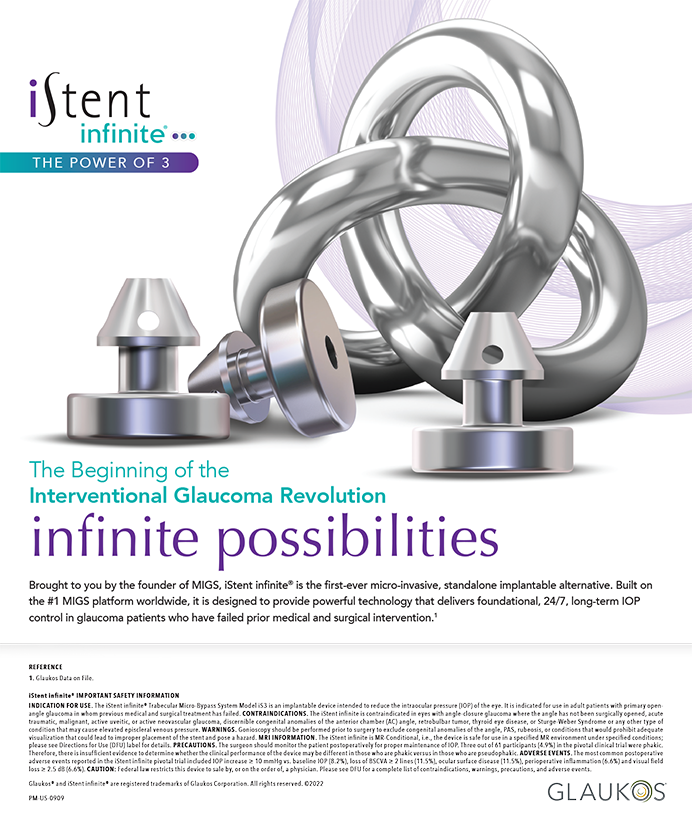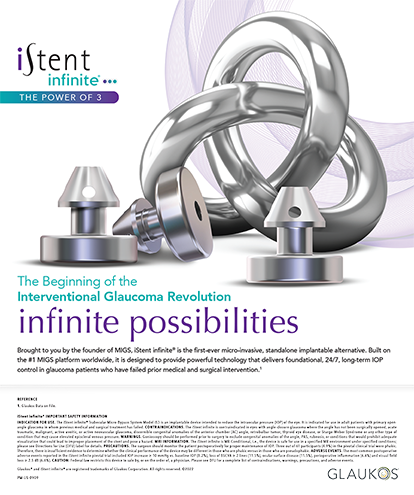Endophthalmitis is a potentially serious complication in cataract surgery. The incidence of this disease in post-cataract surgery is approximately 0.08%. Speaker et al1 investigated the role of external bacterial flora in the pathogenesis of acute post-operative endophthalmitis. They showed in 82% of endophthalmitis cases that isolated from the vitreous, the organism was genetically indistinguishable from an isolate retrieved from the patient's eyelid, conjunctiva, or nose.
Two principal treatments reduce bacterial flora on the ocular surface: preoperative topical antibiotics (a skin preparation with 10% povidone-iodine), and 5% povidone-iodine administered preoperatively into the conjunctival cul-de-sac. Povidone-iodine is a safe periocular skin and conjunctival antiseptic that is effective against bacteria, viruses, fungi, protozoa, and spores. It disrupts cell membranes on contact, killing the microorganisms, acts rapidly, and can be instilled immediately prior to surgery. Speaker and Menikoff2 examined surgical prophylaxis using topical 5% povidone-iodine, and found a significantly lower incidence of culture-positive endophthalmitis (P<.03) compared to using silver protein solution. They reasoned that reducing ocular surface flora is most likely the best method in preventing endophthalmitis.
Dereklis et al3 showed reduced positive conjunctival cultures, from 66% of eyes to 30% of eyes, after instilling one drop of 5% povidone-iodine. Isenberg and Apt4 demonstrated that when topical polymyxin B sulfate-neomycin sulfate-gramicidin ophthalmic solution (Neosporin,® Burroughs Wellcome Co; Research Triangle Park, NC) and 5% povidone-iodine solutions were used separately, each caused a similar and substantial decrease in the number of colonies and species of bacteria cultured. However, when both drugs were combined, conjunctival flora was reduced to a greater degree than when either agent was used alone.
Fluoroquinolone antibiotics are greatly effective against most pathogenic organisms, with the exception of anaerobes. The four fluoroquinolones currently available for use in ophthalmology are Chibroxin® (norfloxacin, Merck & Co, Inc., West Point, PA), Ciloxan® (ciprofloxacin, Alcon; Forth Worth, TX), Ocuflox® (ofloxacin, Allergan; Irvine, CA) and QuixinTM (levofloxacin, Santen Inc.; Napa, CA).
Norfloxacin is less potent than the other three fluoroquinolones, and is used infrequently for ophthalmic indications. Ciprofloxacin and ofloxacin are extremely potent against a broad range of ocular organisms. QuixinTM is a recent addition to fluoroquinolone antibiotics. Levofloxacin is approved by the FDA to treat conjunctivitis, but not keratitis.
In general, ciprofloxacin shows greater potency against the majority of the organisms responsible for endophthalmitis. However, ofloxacin appears to penetrate ocular tissues somewhat more effectively than ciprofloxacin. The levels at which ofloxacin penetrates the anterior chamber are higher, but still subtherapeutic. In the case of surgical prophylaxis, tear levels of antibiotics are extremely important. Studies indicate that tear levels of ciprofloxacin are higher than ofloxacin with equivalent topical dosing.
The inhibitory quotient compares antimicrobial activity of various antibiotics by integrating tissue levels of antibiotic with the MIC90 of the antibiotic against a particular organism. Higher inhibitory quotient values indicate a higher level of the antibiotic relative to the MIC90. Diamond et al5 studied the relative corneal penetration of topical fluoroquinolones, excluding levofloxacin, and related them to the MIC90s for organisms associated with bacterial keratitis. Although they found that the intracorneal concentration of ofloxacin was significantly higher than ciprofloxacin and norfloxacin, they determined that the greater potency of ciprofloxacin offset the superior penetration of ofloxacin. Madaras-Kelly6 et al studied time concentration kill curves against two strains of Pseudomonas aeruginosa, and found that ciprofloxacin achieved a 3 log10 kill of each strain more rapidly than ofloxacin.
Because in vitro results do not always correlate to clinical effectiveness, we designed an in vivo study to compare ciprofloxacin and ofloxacin in eradicating organisms on the ocular surface of volunteers age 55 and older. The purpose of this study was to determine which topical fluoroquinolone (ciprofloxacin 0.3% or ofloxacin 0.3%) was more effective in reducing colony counts of bacterial flora on the ocular surface of healthy volunteers. We also determined the time course of the antibacterial action of ciprofloxacin and ofloxacin on the ocular surface.7 The study contained three arms, each consisting of 20 human eyes. The first arm received no treatment, the second arm received three drops of ciprofloxacin (0.3%), and the third arm received three drops of ofloxacin (0.3%). Each eye was required to have at least 50 colony-forming units (CFU) on the initial culture. After administering the antibiotic drops, we cultured the eyes at 15, 30, 60, and 120 minutes. At each time point, we performed a statistical analysis comparing each treatment arm to the control arm and to each other.
Our study showed that instilling ofloxacin 0.3% did not significantly reduce bacterial CFUs at 15, 30, or 60 minutes. CFUs were marginally reduced compared to those in the control arm at 120 minutes. Ciprofloxacin 0.3% significantly reduced bacterial CFUs compared to no treatment at 15 minutes, an effect that persisted for 2 hours following administration. The amount of bacterial CFUs reduced by ciprofloxacin 0.3% was significantly greater than that reduced by ofloxacin 0.3% at each time point in the study. We concluded that ciprofloxacin 0.3% is highly effective in reducing colony counts on the conjunctiva of human eyes.
In the future, more potent fluoroquinolone antibiotics will be available for ophthalmic use. For example, Avelox® (moxifloxacin, Bayer Corporation; West Haven, CT), which will be licensed to Alcon Laboratories, Inc., and gatifloxacin (Bristol-Myers Squibb, New York, NY), which will be licensed to Allergan, are both fourth-generation fluoroquinolones, and more potent against Gram-positive organisms and effective against bacteria resistant to the fluoroquinolone antibiotics presently available.
1. Speaker MG, Milch FA, Shah MK, Eisner W, et al: Role of external bacterial flora in the pathogenesis of acute postoperative endophthalmitis survey. A 10-year review of incidence and outcomes. Ophthalmol 105:1004-1010, 19982. Speaker MG, Menikoff JA: Prophylaxis of endophthalmitis with topical povidone-iodine. Ophthalmol 98:1769-1775, 1991
3. Dereklis DL, Bufidis TA, Tsiakiu EP, Palassopoulos SI: Preoperative ocular disinfection by the use of povidone-iodine 5%. Arc Ophthalmol (Copernh) 72:627-630, 1994
4. Isenberg SJ, Apt L, Yoshimori R, Khwang S: Chemical preparation of the eye in ophthalmic surgery. IV. Comparison of povidone-iodine on the conjunctiva with a prophylactic antibiotic.
5. Diamond JP, White L, Leeming JP, Bing Hoh H, et al: Topical 0.3% ciprofloxacin, norfloxacin, and ofloxacin in the treatment of bacterial keratitis: A new method for comparative evaluation of ocular drug penetration. Br J Ophthalmol 79:606-609, 1995
6. Madaras-Kelly KJ, Larsson AJ, Rotschafer JC: A pharmacodynamic evaluation of ciprofloxacin and ofloxacin against two strains of Pseudomonas aeruginosa. J Antimicrob Chemother 37:703-710, 1996
7. Snyder-Perlmutter LS, Katz HR: Effect of topical ciprofloxacin 0.3% and ofloxacin 0.3% on the reduction of bacterial flora on the human conjunctiva. J Cataract Refract Surg 26:1620-1625, 2000


